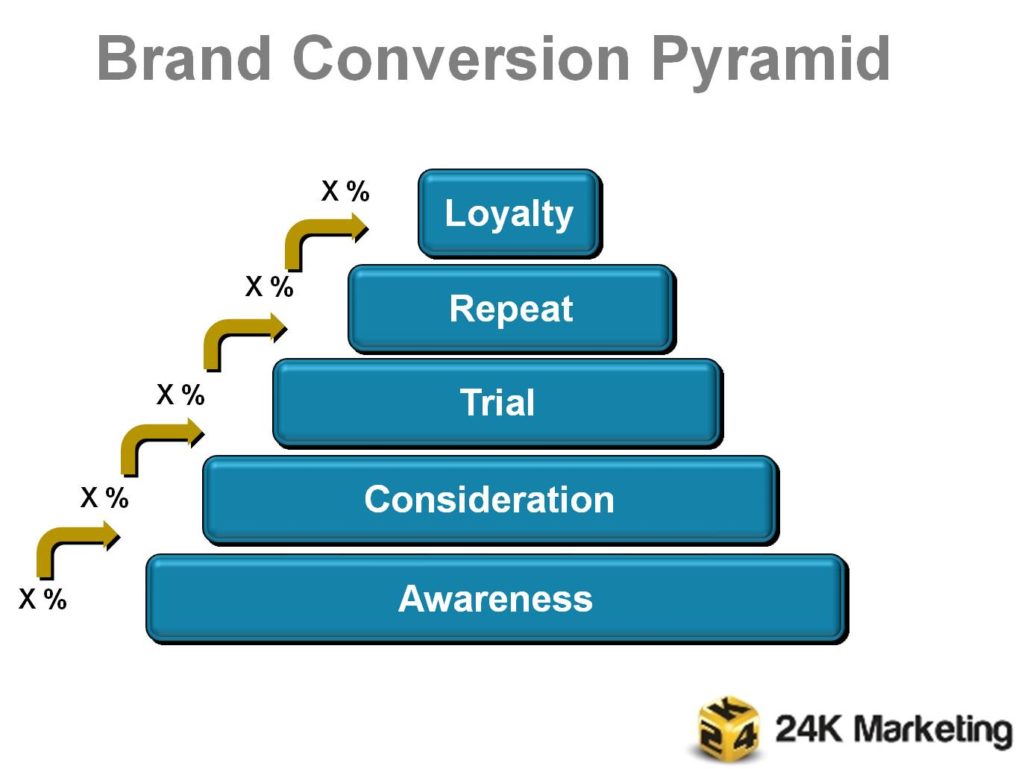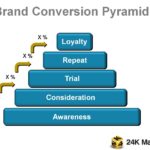Summary
Building awareness of a brand in the consumer’s mind is the first step in selling a product. It is a discreet first step along the consumer’s path to purchase. Marketers and sales professionals often overlook the step while focusing instead on the downstream step of converting potential users into a paying customer. However, the conversion process is more difficult without creating initial awareness first and lowering the number of prospects that would even consider purchasing. It is easy to measure that level of awareness among a target group and there are specific steps to improve that level. This article shows why awareness is important and specific steps to improve it for your business.
Background
The purchasing decision process follows consistent steps. The first step is always an awareness of a business or brand. This is true whether it is selling consumer products through brick and mortar stores, selling online or selling business to business through a personal selling process.
Think of any category of products or services. Think of breakfast cereals, laptop computers, insurance companies, etc. It’s easy to name the top brands in each of those segments. While we each have a favorite brand in each category, we are “aware” of many others and may one day switch brands when looking for something new or better. That switch will be to a brand we already know.
Example
I like one example within the car insurance industry. A growing car insurance business called GEICO, created an ad campaign and vaulted themselves to the number 3 car insurer in the country, behind State Farm and Allstate. All without the traditional insurance agent network. Offering low prices to a consumer target interested in low prices rather than the traditional (and likely more expensive) model
The brand was not a powerhouse advertiser. It started as the Government Employees Insurance Company (GEICO) back in 1936. Berkshire Hathaway purchased GEICO in the 1990s and invested in high quality advertising. The target market for car insurance includes all licensed drivers in the US so national television, radio, billboards, and more digital placements are most efficient
Geico satisfies customers by offering savings on insurance if you switch from the larger car insurance companies. This benefit-based message appears in each ad along with a visual way to remind you of the brand name – the gecko lizard.
How it Worked:
Awareness building activity is effective because the moment a driver decides they are not happy with their current car insurance premiums (most of us when our bill is due) the awareness of a lower cost alternative is in our mind. The tagline is calls out what you need to do at that very moment with one easy call “15 minutes can save you hundreds on your car insurance” tagline. The awareness is already there so there is no need to turn to Google to look up car insurance options.
The same approach with different tactics work for small and mid-sized business too. It is difficult to know when the target customer starts looking for a new solution to their needs.
Start with a definition:
Awareness – knowing and remembering a brand name
Awareness level (metric) – the percentage of the total potential target market that has heard of and remembers a brand’s name.
Simply stated, you can’t sell something to someone if they are unaware it exists. Marketers often miss the opportunity to develop a broad base of potential customers that know of the brand and what it does. Why miss building a broad base of people that know of your brand? Converting potential customers to purchasers comes later.
Consumers eventually seek new solutions. The problem is knowing when and the answer is not in your control. Maybe years or it can happen in a moment. An “aware” consumer has the chance to choose your brand.

Brand Conversion Pyramid
Brand Conversion Pyramid shows the consumer path that leads from Awareness through Loyal consumer. The pyramid illustrates 3 points. First, consumers journey along a predictable path from awareness to loyalty. Second, each step along the way is a smaller subset of the group before. Third, each group’s size at every stage can be measured. Once measured, marketing activities should focus on improving conversion problems. For more information on this, click here.
Steps to building awareness
- Define a target –
- Who are the potential people most likely to need your service or product? Look at age, family status, profession.
- What do they struggle with in your product’s category and how would this make them interested in your product?
- Where does the target live and work and what geographic location do you want to impact?
- How many of them are there?
- Establish a single, unique message
- Find the place where the consumer is most likely to see this message
- Use your agency to define. If you don’t want to assign this task to an agency, you can have fun brainstorming by putting yourself in the shoes of your target. What do they do, where do they go every day, who do thy work with, socialize with and where would you find them?
- Select the best place to reach the target and place your message there. It could be through traditional media, online and social media. Maybe a creative placement in the community where messages stand out.
- Whatever the placement, connect a single message to your brand and make the name memorable (the real reason for the gecko for GEICO).
Measuring Awareness:
Use a reliable and project-able sample and design a simple questionnaire. Confirm that they use the category and match the demographics of the brand’s target customer. Use the following questions:
- Unaided awareness: what brand come to mind when you think of XXX category. List all you can remember.
- Aided awareness: Have you heard of the following brands: (list all that apply including your brand).
With the results of the survey, calculate the number of aided awareness to the total survey of the target. That is the percent aware of your brand.
Building awareness is a marketer’s first step along the consumer’s path to purchase. Converting target consumers to respond to buying and become loyal is easier when specific activities designed only to build awareness of your brand.



[…] Awareness – have heard of and remembers the brand name. More on awareness here […]